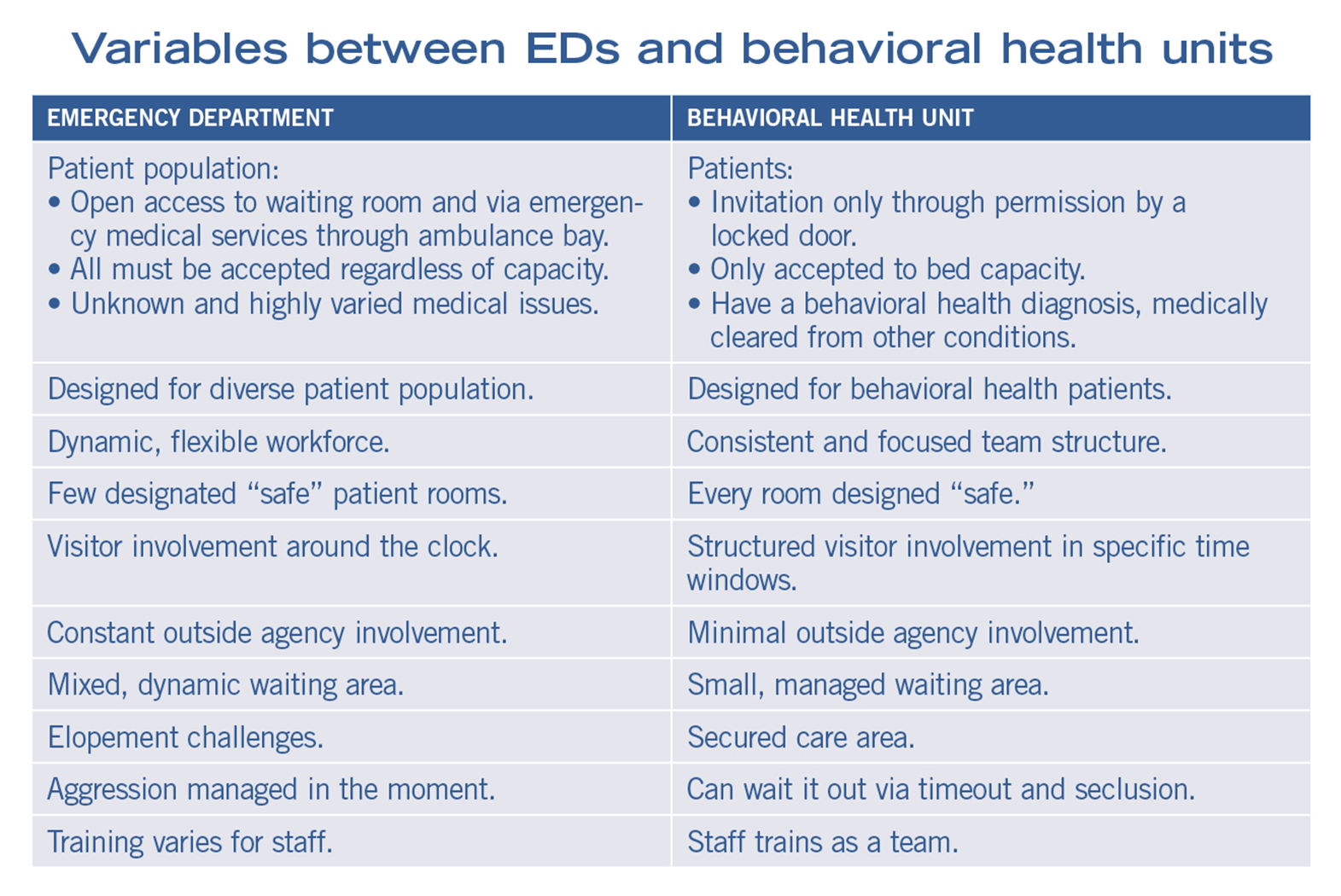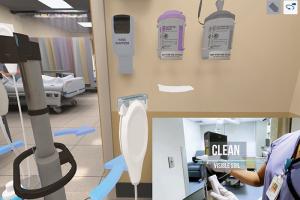Violence prevention strategies for emergency departments

The integration of electronic security technology provides the ability to improve the overall effectiveness of all other implemented security practices.
Image courtesy of HSS Inc.
Each day, health care emergency department (ED) staff across the country are confronted with challenging situations they know very little about when the individual patients first arrive.
In most situations, experience and training allow staff members to execute an appropriate response. However, more and more frequently, patients are challenging the safety of both the individual provider and the care environment.
While there are financial impacts of violence, there are other, greater costs as well. Consider the emotional toll violence has on staff and their employers. These psychological impacts can include burnout, absenteeism and dissatisfaction that may eventually lead to employee turnover.
To prepare for such situations, health care organizations must develop customized violence prevention strategies geared specifically to their EDs.
ED violence challenges
Staff are much more likely to be injured in EDs than any other area in the hospital. This is due to several factors, including environmental design, patient volume and wait times, lack of staff training, and the unknowns associated with the medically diverse patient population.

Unlike any other care area in the hospital, the situational unknowns faced by ED care providers are especially impactful. This is due to a number of factors, such as the following:
- Care providers know little about the patient’s condition, medical history or mental status when they arrive.
- Patients often arrive fully clothed, sometimes with bags of property that could include any number of items meant to cause bodily harm to themselves or to others.
- Patients may be the victim or the aggressor in a violent act.
- Patients often arrive with family and friends who may help or hinder the care of the patient.
- Many patients have behavioral health issues that can affect the provider’s ability to address other immediate medical needs.
- Patients with behavioral health issues may need to stay in the ED for extended periods of time while a more appropriate care option is located.
Because of these environmental and patient variables, health care providers must manage the ED, and the associated safety risks to staff, patients and visitors, differently than any other care environment in the hospital.
The table on page 36 shows the variables between EDs and behavioral health units, which are the two patient care units most commonly associated with patient generated violence toward staff.
While behavioral health professionals would agree that no two behavioral health patients are alike, neither are the ED and behavioral health units themselves. The ED is a uniquely different care environment and should have a unique security and violence prevention training plan.
Assessing the factors
Each health care facility should start with a plan that leads with personal safety, because data show that when staff routinely create a proactively safe care environment, it results in less violent patient and staff encounters.
Professionals should start by conducting a focused security assessment. They should consider hiring a reputable consulting firm with qualified health care security professionals to evaluate their violence prevention and mitigation strategy against health care security standards.
This assessment should consider all the elements that impact the ED and its patients, visitors and staff, including:
Community and hospital factors. What are the characteristics of the community? Facility professionals should start with a CAP Index® score for crimes against persons, then evaluate the statistics around patient volume. They should consider number of annual visits, peak load times, patients with a primary or secondary behavioral health diagnosis, and average length of stay. Then, they should create a risk stratification model that positions the hospital against similar hospitals based on CAP and patient volume, two independent variables that have statistical significance as it relates to violence in the ED. The goal is to determine if the unit is a low-, medium- or high-risk environment and allows that data to inform the type of security presence, system integration and training solution the hospital will deploy.
What happens in an ED undoubtedly reflects what is happening in its community. Is there a commonly used drug, and what are the medical side effects? Are patients coming in relaxed or aggressive? Are there gangs operating in the community and how does staff recognize a gang member? What happens when weather or temperatures shift? Is there an influx of homeless people and what issues accompany this patient population?
These are some of the questions health facility professionals and their teams should answer or be prepared to answer every day.
Design. Facility professionals should start at the parking area supporting the unit and consider every part of the waiting and care environment touched by the patient and visitor from admission through discharge. Preparations could be as routine as making sure pictures are permanently affixed to the wall or as complicated as planning how an at-risk patient’s room is configured.
According to the International Association for Healthcare Security & Safety’s (IAHSS’s) Security Design Guidelines for Healthcare Facilities, the physical design of the ED in particular should promote an all-hazards approach to the safety and security of those working in, visiting or seeking emergency services from the health care facility.
The security layout and design of the ED should be viewed as a protected area that serves as an added layer of safety among the health care facility, public and treatment areas. When making design considerations, the organization should ask: Does the ED, from door in to door out, work to create a safe staff and patient environment?
The IAHSS guidelines can be purchased on the group’s website.
Security presence. Given the level of potential or actual violent events inside health care facilities, health care administrators recognize the importance of having an appropriate security officer presence.
Security professionals are the first line of defense when it comes to protecting patients, visitors and staff in emergent situations. Security presence inherently sends an everyday message that the organization takes the need to create and maintain a safe care environment seriously.
Security presence takes many forms, from a physically imposing “gentle giant” to a physically slight de-escalation expert. It can also come with highly trained security officers who have approved use-of-force tools or licensed police officers working off-duty in the ED.
Regardless of who is working security, they must have the presence that comes from being a calm, self-confident and well-trained security officer.
Security training. The quality, quantity and sequencing of security officer training is critical to the overall success of any health care security program. This is no more apparent than in the ED, where design, staffing, tension, emotions and dealing with the unknown are an everyday, almost hourly, occurrence.
Health care organizations should create a competency-based training program for its security officers. In addition to the everyday situations officers face, they should be trained to recognize behaviors associated with certain types of at-risk patient populations. Leadership should evaluate the officer’s ability to successfully intervene in difficult situations and arrive at win-win solutions.
Security system integration. A practical electronic security strategy, when combined with physical security presence, enhances the overall security posture of the ED exponentially.
The integration of electronic security technology in the ED provides the ability to improve the overall effectiveness of the remaining security practices. It also enables the ED to be more productive while making better use of security personnel resources.
A health facility’s systems integration plan should include many items, such as access control tools, video surveillance, metal detection, panic buttons, status alert systems, restricted access capabilities, and “safe” patient and staff rooms, among others.
Hospital staff training. Violence threatens the safety of ED staff, patients and visitors in hospitals of all sizes and settings. The failure to train staff appropriately is typically the biggest missed opportunity in health care security.
According to a study reported in The Journal of Nursing Administration, nearly one in four ED nurses experienced frequent physical violence over a three-year period. The team members themselves, ultimately, need to feel confident and empowered to protect their own safety, understanding all of the factors and tools available to them as they encounter these situations directly.
This, too, is an area where the support of outside specialists can help ensure thorough training is implemented across all levels of department staff.
Multifaceted strategy
A health care organization’s ED unit will then need to craft a unique, two-part structured violence prevention and mitigation program that creates an everyday sense of confidence and safety. These parts include an Emergency Department Security Management Plan and an Aggression Management Training Plan.
The Emergency Department Security Management Plan assists organizations with building a comprehensive event-driven security plan that blends physical security, policies and practices, and staff training. It also provides ED staff with a proactive plan to recognize, understand, react to and manage security issues before they become full-blown problems.
When integrated into full employee onboarding efforts for all new hires, and ongoing employee refresher education programs, it makes personal and environmental safety precautions an everyday extension of what busy staff members already do.
As a closely tied operational tool, the Aggression Management Training Plan assists staff in recognizing factors, hazards and situations that can escalate to aggression and violence. Aggression certainly functions as its own unique kind of violence challenge, and this plan specifically tackles this more obtuse form of violence. An Aggression Management Training Plan would explain to team members the key elements of the aggression cycle, as well as how and when to use de-escalation techniques to deal with aggression and the potential of violence. It should also teach health care-specific strategies and skills designed to protect staff from physical attack.
Above all else, any ED should start by creating a plan that leads with personal safety first, because when staff routinely create a proactively safe care environment, it inevitably results in less violent patient and staff encounters.
No. 1 challenge
Patient-generated violence directed at caregivers is the No. 1 security challenge facing today’s health facility professionals. No matter the source of the data, the story remains the same: caregivers, especially those working in hospital EDs, routinely face violence, and the physical, emotional and financial costs of combating this problem have real impact.
However, patient-generated violence in the ED, short of the rare illogical and explosive event, can be manageable. It starts and ends with the right violence prevention and mitigation strategy, tailored to the ED and brought together with a proactive environmental management and staff training program.
Alan Butler, CHPA, is the senior vice president of health care security at HSS Inc., based in Denver. He is also 2019 board president of the International Association for Healthcare Security & Safety. Butler can be reached at abutler@hss-us.com.




